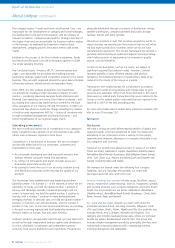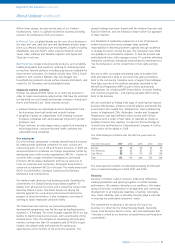Unilever 2007 Annual Report Download - page 20
Download and view the complete annual report
Please find page 20 of the 2007 Unilever annual report below. You can navigate through the pages in the report by either clicking on the pages listed below, or by using the keyword search tool below to find specific information within the annual report.
18 Unilever Annual Report and Accounts 2007
Report of the Directors continued
Operating Review – Regions continued
The Americas (continued)
all Small & Mighty concentrated liquid detergents. These use
reduced-size packaging to save water, cardboard and energy in
production, packaging and transport. They are also easier for
consumers to carry, pour and store. We then applied all Small &
Mighty’s product technology to fabric conditioners, creating
Snuggle Exhilarations – a three-times more concentrated premium
sub-range delivering superior fragrance. In Brazil, Omo has been
further strengthened with a new top-performance product
including baby and foam control variants.
The operating margin, at 15.8%, was 2.8 percentage points
higher than in 2005. There were lower costs for restructuring,
disposals and impairments, and a one-time benefit in 2006 of
€146 million from changes to US healthcare plans. In 2005 there
was a gain on the sale of an office. Before these items the
operating margin would have been 0.3 percentage points lower
than the previous year. Innovation-driven marketing mix, pricing
and productivity offset high commodity costs. Advertising and
promotions were increased to support major brand launches.
Asia Africa
2007 compared with 2006
€ million € million
2007 2006
Turnover 11 540 10 863
Operating profit 1 596 1 327
Operating margin 13.8% 12.2%
Restructuring, business disposals and impairment
charges included in operating margin 1.1% (0.3)%
%
Underlying sales growth at constant rates 11.1
Effect of acquisitions 0.1
Effect of disposals (0.4)
Effect of exchange rates (4.0)
Turnover growth at current rates 6.2
%
Operating profit 2007 vs 2006
Change at current rates 20.2
Change at constant rates 27.6
Turnover at current rates of exchange rose by 6.2%, after the
impact of acquisitions, disposals and exchange rate changes as set
out in the table above. Operating profit at current rates of
exchange rose by 20.2%, after including an adverse currency
movement of 7.4%. The underlying performance of the business
after eliminating these exchange translation effects and the
impact of acquisitions and disposals is discussed below at
constant exchange rates.
The strong underlying growth of 11.1% for the year reflects both
the vibrancy of these markets and the high priority we place on
building our business in the region. It includes a healthy balance
of volume and price, up by over 7% and 3% respectively.
Growth was consistent throughout the year and was broad-based
across categories and countries, including established markets
such as India, Indonesia, the Philippines, South Africa and Turkey,
which all grew in double digits; significant product areas such as
laundry and personal wash; and emerging product areas like ice
cream and deodorants. China remains a key priority and grew
strongly for the third consecutive year.
We drove growth across all income levels, from highly affordable
packs to premium positions. This was supported by new brands
and products that leveraged our global platforms and excellent in-
market execution.
The operating margin, at 13.8%, was 1.6 percentage points
higher than last year. This included the €214 million accounting
profit resulting from the reorganisation of our shareholdings in
South Africa. Before the effects of this transaction, disposals and
restructuring charges, the operating margin showed an underlying
increase of 0.2 percentage points. The improvement was driven
by volume growth, pricing actions and savings programmes which
more than offset higher input costs and increased advertising and
promotions.
We announced the acquisition of the Buavita brand of fruit-based
vitality drinks in Indonesia, which was completed early in January
2008.
As part of the One Unilever programme we now have a single
SAP system in place in four countries as the basis for a common
regional platform, while the reorganisation of our shareholdings
in South Africa and Israel facilitates the new organisation.
The new, more global, approach to innovation was evident in the
2007 programme. Clear anti-dandruff shampoo was launched in
China, Arabia, Egypt, Pakistan and the Philippines. In Japan, we
launched the Axe brand and Dove pro•age skin care products. An
improved range of Dove shower products was extended to North
East Asia, while Lifebuoy soap was launched in South Africa and a
new variant brought to India. In laundry, the new Dirt is Good
product, packaging and communication were introduced to
Thailand.
The Moo range of ice creams was extended throughout the
region. Knorr seasonings were rejuvenated with premium
ingredients, as in Europe, and in China we launched a new form
of Knorr bouillons for preparing thick soups. At the same time
new, more affordable, tubs and sachets are attracting new users
of spreads in several countries.
























